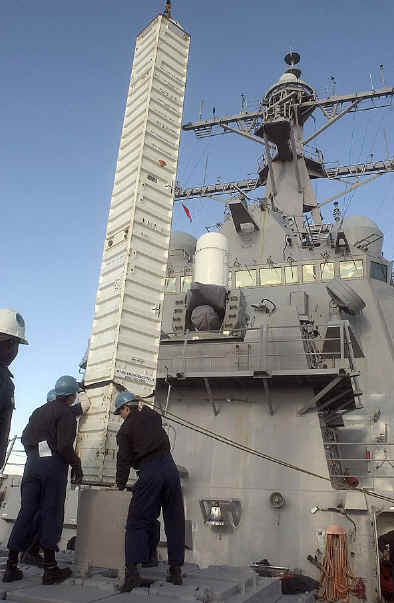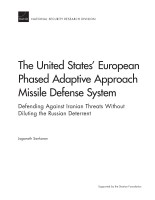_____________________________________________________
Most American politicians support spending on a national missile defense system. However, some technical issues remain beyond our level of sophistication. Continued research and development is justifiable, but military contractors discovered that money can be made by pretending a system exists. In 2011, I wrote about a fraudulent missile defense scheme. Major military contractors collect billions of dollars in taxpayer funds each year to build and deploy SM-3 missiles worldwide to protect against Intermediate Range Ballistic Missiles (IRBM) and Inter-Continental Ballistic Missiles (ICBM), even though they lack the range to hit them.
 The bigger the missile the greater the range, which I explain
in detail in my 2011 article. The SM-3 size is constrained by the requirement
that it fit into the Navy MK-41 launcher. (loading pictured) Early versions of the SM-3 could
only reach 90 miles high, while IRBMs and ICBMs arc 300-750 miles overhead. Raytheon
was given billions of dollars over two decades to increase range by tweaking
engine performance and adding propellant by maximizing the size of a missile
that can fit in an MK-41. This nearly doubled the SM-3's altitude, yet remains far too limited for
American and European missile defense.
The most range demonstrated is listed by the great missile website Astronautica:
The bigger the missile the greater the range, which I explain
in detail in my 2011 article. The SM-3 size is constrained by the requirement
that it fit into the Navy MK-41 launcher. (loading pictured) Early versions of the SM-3 could
only reach 90 miles high, while IRBMs and ICBMs arc 300-750 miles overhead. Raytheon
was given billions of dollars over two decades to increase range by tweaking
engine performance and adding propellant by maximizing the size of a missile
that can fit in an MK-41. This nearly doubled the SM-3's altitude, yet remains far too limited for
American and European missile defense.
The most range demonstrated is listed by the great missile website Astronautica:
2013 September 19 - . 00:32 GMT - Launch Site: Barking Sands. Launch Pad: USS Lake Erie. Launch Platform: CG-70. LV Family: Standard. Launch Vehicle: SM-3-IB.
- Aegis KV - . Nation: USA. Apogee: 300 km (180 mi). Anti-ballistic missile. The Aegis missiles were stated to have reached a record altitude for the type, in excess of the 250 km achieved in the 2008 USA 193 antisatellite test.
More recent tests no longer disclose the altitude at intercept since Congress might ask why longer range intercepts are not attempted. They might learn the Aegis AN/SPY-1D radar has a maximum range of only 175 miles. We are told this doesn't matter because "other radar" hundreds of miles away will feed data to Aegis to guide the SM-3. This will never occur even during scripted tests because even the latest SM-3s can't reach beyond that altitude.
This limitation resulted in creative marketing that led to blatant fraud as salesmen claim the SM-3 can be used for European and American national missile defense. As I explain in my 2011 article, missile contractors and allies in the Pentagon provided range data to Congress that assumed enemy missiles would fly a low "depressed trajectory" of less than 150 miles high directly over SM-3 missile launchers so they could hit them, rather than a normal "lofted" ballistic trajectory of over 300 miles high. This would also require a row of hundreds of SM-3 launch sites to protect Europe since each site could only cover a 40 mile swath.
Since this concept was absurd, a covert effort began to lie about SM-3 range. Raytheon conspirators simply claimed the SM-3 can protect against IRBMs and ICBMs! There is no computer model nor projected SM-3 performance data on any Pentagon or Raytheon website to back this claim. This bogus range data first appeared in 2013 in an military industry funded website "Breaking Defense" where a Dutch assistant professor announced that an SM-3 can hit targets 1350 miles away! He included several nice charts, but cited no source data. This false claim was immediately inserted into the SM-3 Wikipedia entry and appeared in news stories and websites. The SM-3 Wikipedia entry magically improved range from 130 miles to 1350 miles! I searched websites and news stories attempting to learn how anyone could justify the idea that SM-3s can shoot down long range missiles. I finally found the answer in a 2015 Rand report:
"The methodology employed to perform the calculations discussed in this report assumes
impulsive interceptors and missiles that spontaneously obtain their entire velocity immediately
upon launch. This assumption is made to simplify the mathematical complexity. Similarly, the
calculations were done assuming no air drag and a nonrotating Earth. The modeling of the
interception was done assuming perfect tracking information and no countermeasures from the
target missile. The end game of the interception process was also not modeled. Given the ranges
and times involved in comparing the kinematic reach of different interceptors, these assumptions
and
simplifications are reasonable for a first-order estimation."

This was buried in a long, detailed report that shocks anyone with a basic knowledge of flight. Using just maximum velocity to determine range "to simplify the mathematical complexity" could be justified to teach elementary school children multiplication: (distance x speed). Calculating acceleration and air resistance as fuel is consumed and air density lessens requires complex calculus, not to mention the pull of gravity. Fortunately, American scientists have performed this task on chalkboards since the 1930s, and now we have computers! This is required for all space launches! There are even websites with simple on-line calculators where anyone and punch in basic data to get a good "first-order estimation." The SM-3 program began two decades ago, not two weeks ago, so Raytheon is well beyond "first-order estimations".
An outlandish simplification in the Rand report was "calculations were done assuming no air drag". Air resistance is the primary obstacle to intercept. A surface launched missile must catch the target missile that already has a sizable lead. Air resistance slows acceleration and burns more fuel. High speed air friction causes skin heating that can melt the nose or cause it to break open. As a result, missiles in the atmosphere are limited to Mach 3-5. The term MaxQ refers to the maximum velocity a missile can safely fly at a certain altitude without risking self-destruction. One could argue that once a missile reaches 100 miles above Earth, atmospheric particles are so few that air drag can be discounted, but some 90% of the Earth's gravity remains so after burnout a missile is pulled back to Earth and away from its target.
Burnout velocity is the maximum speed a missile reaches just as its fuel is exhausted. The latest SM-3 missile deployed is the SM-3-IIA, which claims a burnout velocity of 4.5 km/sec or 10,000mph (Mach 13!). This may be possible after the missile exits the Earth's atmosphere after two stages are dropped and fuel is exhausted. But most of the missile flight is at less than Mach 4 because of "air drag" and once burnout occurs gravity pulls it back down. Therefore, very long range intercepts require the missile be aimed along an indirect arcing ballistic flight path that is much longer, so long that they cannot catch missiles unless they are flying toward the missile defense launch site. Russian missiles are aimed to fly the shortest route to the USA over the arctic. There is no way any missile fired from Central Europe can catch them!
Yet these impossible conditions were still not enough since the Rand report also assumes "missiles that spontaneously obtain their entire velocity immediately upon launch." Of course several seconds are needed for any missile to reach maximum velocity even without gravity or air resistance, and so G-forces do not squash components. Nevertheless, these calculations assume that it begins flight at its maximum burnout velocity to further falsify performance calculations.
The Rand report is an interesting example of politics. Rand provides detailed outside analysis to support Pentagon plans. However, it is run by smart people and some have integrity. They knew the SM-3 range was greatly inflated, perhaps from reading my 2011 article, and insisted on the reporting this false methodology. They included the paragraph above in blue to warn experts that the entire report is bogus, so Rand deserves some credit for exposing this fraud. Are there people in Congress, the major media, or the Pentagon willing to act on this fraud?
Carlton Meyer editorG2mil@Gmail.com
©2017 www.G2mil.com
Feb 2018 Update
It has now become acceptable to assert that the SM-3 can shoot down Intermediate (IRBM) and Inter-continental (ICBM) ballistic missiles. Nearly everyone assumes this can occur while the missile arcs overhead, but even the latest SM-3 IIA lacks half the range to hit one. Experts know this, but always backtrack when pressed and mumble about engaging during the launch or terminal phase.
The same could be said of shoulder fired RPGs. One could fire a $50 rocket at a launching ICBM from 200 meters away and "shoot it down." One could fire a $50 rocket at an ICBM just before it strikes the ground 200 meters and may "shoot it down." Likewise, an SM-3 should be able to hit an ICBM soon after launch if within 50 miles, and may be able to hit an ICBM just before it hits if within 50 miles. Small SM-3s cannot provide broad missile defense simply because they cannot reach bigger high-flying missiles.
Most people are unaware of this deception and assume the SM-3 is a useful national defense missile that can shoot down missiles arcing 300 to 500 miles overhead, but it can only reach 150 miles high, so tests are always much lower. A recent example of this deception was a January 31, 2018 test where an SM-3 IIA attempted to hit an "intermediate-range" target called the Naval Strike Missile. This missile has a range of just 115 miles, and is a turbojet sub-sonic cruise missile that can't fly more than 10 miles high!
This $130 million test was promoted as showing the latest SM-3 IIA can shoot down IRBMs, but this non-ballistic target was a cruise missile flying less than 10 miles high, not 300 miles high, and it still missed! No excuse was provided, but the last test also missed and was explained by a ridiculous excuse. Admirals claim the missile was accidentally destroyed because their $130 million tests are not conducted by experts, but by lowly enlisted men and one pushed the wrong button.
In addition, the Navy just fielded the new SM-6 missile to shoot down cruise missiles, so why did it spend $130 million for this bogus test? Probably to score another easy successful shoot-down of a slower short range missile to support additional purchases of SM-3s by pretending they can shoot down IRBMs and ICBMs. Meanwhile, the Navy has been touting successes of the SM-6 as missile defense progress, even though it cannot hit targets more than 20 miles high since it uses fins for steering control that do not work outside the atmosphere.